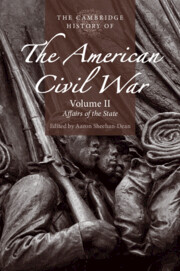Book contents
- The Cambridge History of the American Civil War
- The Cambridge History of the American Civil War
- The Cambridge History of the American Civil War
- Copyright page
- Contents
- Contributors to Volume II
- Note on the Text
- Part I Causes
- Part II Managing the War
- 4 Strategy, Operations, and Tactics
- 5 Union Military Leadership
- 6 Confederate Military Leadership
- 7 Technology and War
- 8 Armies and Discipline
- 9 Financing the War
- 10 Guerrilla Wars
- 11 Occupation
- 12 Atrocities, Retribution, and Laws
- 13 Environmental War
- 14 Civil War Health and Medicine
- 15 Prisoners of War
- Part III The Global War
- Part IV Politics
- Index
- References
9 - Financing the War
from Part II - Managing the War
Published online by Cambridge University Press: 11 October 2019
- The Cambridge History of the American Civil War
- The Cambridge History of the American Civil War
- The Cambridge History of the American Civil War
- Copyright page
- Contents
- Contributors to Volume II
- Note on the Text
- Part I Causes
- Part II Managing the War
- 4 Strategy, Operations, and Tactics
- 5 Union Military Leadership
- 6 Confederate Military Leadership
- 7 Technology and War
- 8 Armies and Discipline
- 9 Financing the War
- 10 Guerrilla Wars
- 11 Occupation
- 12 Atrocities, Retribution, and Laws
- 13 Environmental War
- 14 Civil War Health and Medicine
- 15 Prisoners of War
- Part III The Global War
- Part IV Politics
- Index
- References
Summary
As the guns of civil war fell silent across a scarred American landscape, one Confederate leader supposedly quipped, “the Yankees did not whip us on the field. We were whipped in the Treasury Department.” He was partly right. The American Civil War cost the federal government $3.2 billion and for the Confederacy, some $2 billion. The North raised nearly two-thirds of the requisite funds from the sale of Union bonds, while the Confederacy relied more on churning out Confederate currency (to the tune of $1.5 billion, to say nothing of state currency issues) to cover its expenses. The war itself, however, represented a new chapter in American finance and financial institutions. Financing the war required a degree of state-led financial innovation utterly at odds with American antebellum financial culture. The moral hazards of the anonymous marketplace from the antebellum era quickly became replaced by a statist response that called on all of the citizenry (North and South) to embrace an evolving financial world punctuated by wartime exigencies.
- Type
- Chapter
- Information
- The Cambridge History of the American Civil War , pp. 174 - 192Publisher: Cambridge University PressPrint publication year: 2019



